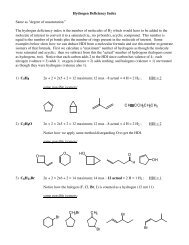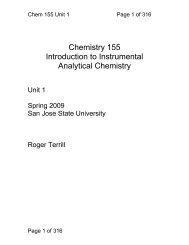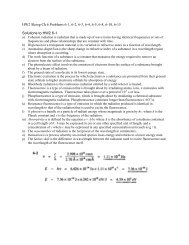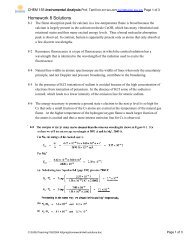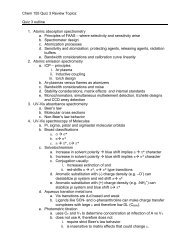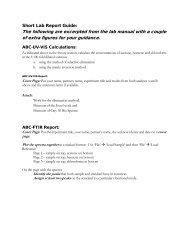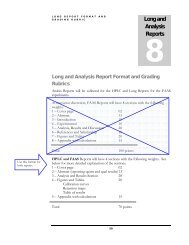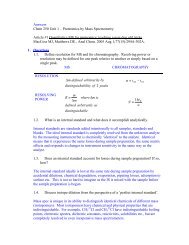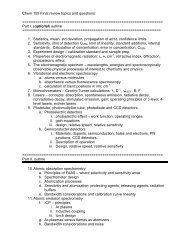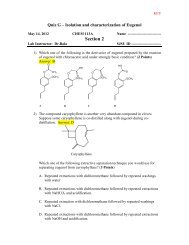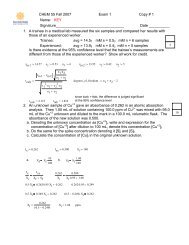Gas Chromatography
Gas Chromatography
Gas Chromatography
You also want an ePaper? Increase the reach of your titles
YUMPU automatically turns print PDFs into web optimized ePapers that Google loves.
<strong>Gas</strong> <strong>Chromatography</strong><strong>Gas</strong>-liquid chromatography (GLC) is an accurate and rapidprocess for separating and analyzing the components of avolatile mixture.This type of chromatography is an example of partitionchromatography, where the separation depends on partitioningof the mixture’s components between two solvents.One of these solvents (called the stationary phase) is adsorbedon a solid support. The other solvent (called the mobile phase)passes through this support.
GC – General Technique<strong>Gas</strong> chromatography involves a sample being vaporized and injected onto thehead of the chromatographic column. The sample is transported through thecolumn by the flow of inert, gaseous mobile phase. The column itself contains aliquid stationary phase which is adsorbed onto the surface of an inert solid.Schematic diagram of a gas chromatograph:
GC - Instrumental componentsCarrier gasThe carrier gas must be chemically inert.Commonly used gases include nitrogen, helium, argon, and carbondioxide.The choice of carrier gas is often dependant upon the type of detectorwhich is used.The carrier gas system also contains a molecular sieve to removewater and other impurities.
GC - Instrumental componentsSample injection portFor optimum column efficiency, the sample should not be too large, andshould be introduced onto the column as a "plug" of vapor - slowinjection of large samples causes band broadening and loss ofresolution.The most common injection method is where a micro syringe is used toinject sample through a rubber septum into a flash vaporizer port at thehead of the column.The temperature of the sample port is usually about 50°C higher thanthe boiling point of the least volatile component of the sample.For packed columns, sample size ranges from tenths of a micro liter upto 20 micro liters.
GC - Instrumental componentsPacked ColumnUsually, a 5 – 10 ft length metal tubing, 3 – 6 mm in diameter, packed with aporous solid that is thinly coated with a high-boiling liquid. The tube is located inan oven that can be heated at a controlled temperature.DetectorA device used to detect each component of the sample as it appears at the exitof the packed column.The intensity or area of the signal indicates the quantity of the elutedcomponent.RecorderA device that provides a record of the analysis
GC – Instrument OperationThe injection block or sample injection port, column oven, and detector are heated to thedesire temperature.The inert carrier gas is passed through the apparatus.Actually the carrier-gas stream is split. Part of it passes through the entire apparatus, andpart of it goes directly to the detector.One common type of detector, called a thermal conductivity detector, consists of two heatedwire filaments, one exposed only to the reference carrier-gas stream, and the other exposedto the effluent gas from the column.
GC – Instrument Operation• First, a small sample of the material to be analyzed is injected• The sample vaporizes in the injection block and is carried through the column,through the detector, and eventually out of the apparatus.• As the sample is eluted from the column and passed through the detector, oneof the detector wires is exposed to a mixture of carrier gas plus sample, and theother wire is exposed only to the reference stream of carrier gas.• The difference between the two gas streams causes a difference in the electricalconductivity of the wires, and this difference is automatically recorded.• In this way a gas – chromatogram is obtained.
How are the components of the mixture separated?• The column is packed with a highly porous, inertpowder (usually silica containing small amounts ofmetallic oxides). This powder is called the solidsupport.• The support is coated with a small amount ( usually 5–10% by weight) of a high boiling liquid before it ispacked into the column.
How are the components of the mixture separated?• Many types of these liquid stationary phases are known:examples include silicone oils, polyesters, and polyethers.• The rate at which a particular component of a mixture passesthrough the column depends on its boiling point, its solubility instationary liquid phase, its polarity, the temperature of thecolumn, and the flow of the carrier gas.• By adjusting these variables, the components of amulticomponent mixture could be separated and analyzed byGC.



